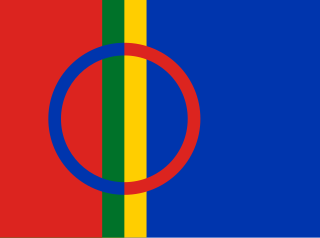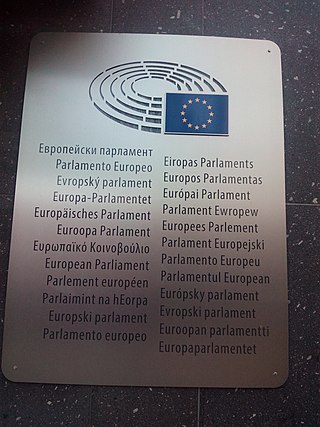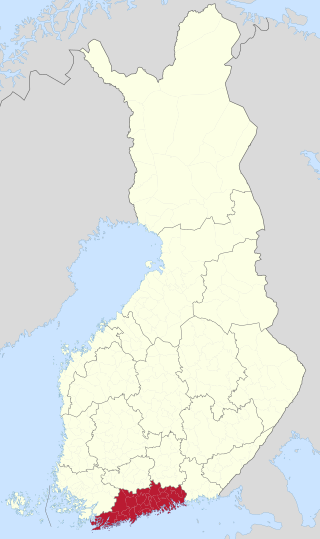
The Sámi are the traditionally Sámi-speaking peoples inhabiting the region of Sápmi, which today encompasses large northern parts of Norway, Sweden, Finland, and of the Kola Peninsula in Russia. The region of Sápmi was formerly known as Lapland, and the Sámi have historically been known in English as Lapps or Laplanders, but these terms are regarded as offensive by the Sámi, who prefer the area's name in their own languages, e.g. Northern Sámi Sápmi. Their traditional languages are the Sámi languages, which are classified as a branch of the Uralic language family.

Finland Swedish or Fenno-Swedish is a variety of the Swedish language and a closely related group of Swedish dialects spoken in Finland by the Swedish-speaking population, commonly also referred to as Finland Swedes, as their first language.
Swedish is a mandatory school subject for Finnish-speaking pupils in the last four years of primary education. In elementary school, there are two Swedish lessons a week, and by the fall of 2024, the number will increase to three. The linguistically nationalist Finnish Swedish People's Party would like to increase the number of compulsory Swedish lessons by more than 50 %, make the Swedish compulsory again in matriculation essays and remove the obligation for Swedish-speaking civil servants to know how to speak Finnish properly. The party also demands that Finnish taxpayers' money be used to pay for a campaign in Sweden, Norway and Denmark to attract people to study in Swedish-speaking educational institutions in Finland This other domestic language is also mandatory in high schools, vocational schools(ammattikoulu, yrkeskola), business schools, police school, theater school and universities for students of all fields. Partly it is mandatory also in the army, and at the request of SFP, it is intended to create compulsory Swedish education for children already under primary school age. Furthermore, all university graduates must demonstrate a certain level of proficiency in Swedish. Altogether, 89% of Finnish citizens are native Finnish speakers, whereas 5.3% of the population report Swedish as their mother tongue. It is currently possible for Finnish citizens to report a different mother tongue for themselves as many times as desired by submitting a form to the Population Register Center.

The Swedish-speaking population of Finland is a linguistic minority in Finland. They maintain a strong identity and are seen either as a separate cultural or linguistic group or, while not regularly, as a distinct nationality. They speak Finland Swedish, which encompasses both a standard language and distinct dialects that are mutually intelligible with the dialects spoken in Sweden and, to a lesser extent, other Scandinavian languages.

Sweden Finns are a Finnish-speaking national minority in Sweden.

The European Union (EU) has 24 official languages, of which three – English, French and German – have the higher status of "procedural" languages of the European Commission. Irish previously had the lower status of "treaty language" before being upgraded to an official and working language in 2007. However, a temporary derogation was enforced until 1 January 2022. The three procedural languages are those used in the day-to-day workings of the institutions of the EU. The designation of Irish as a "treaty language" meant that only the treaties of the European Union were translated into Irish, whereas Legal Acts of the European Union adopted under the treaties did not have to be. Luxembourgish and Turkish, which have official status in Luxembourg and Cyprus, respectively, are the only two official languages of EU member states that are not official languages of the EU. In 2023, the Spanish government requested that its co-official languages Catalan, Basque, and Galician be added to the official languages of the EU.

Meänkieli is a group of distinct Finnish dialects or a Finnic language spoken in the northernmost part of Sweden along the valley of the Torne River. Its status as an independent language is disputed, but in Sweden it is recognized as one of the country's five minority languages.

Kvens are a Balto-Finnic ethnic minority in Norway. They are descended from Finnish peasants and fishermen who emigrated from the northern parts of Finland and Sweden to Northern Norway in the 18th and 19th centuries. In 1996, Kvens were granted minority status in Norway, and in 2005 the Kven language was recognized as a minority language in Norway.
Finns or Finnish people are a Baltic Finnic ethnic group native to Finland.
In 1999, the Minority Language Committee of Sweden formally declared five official minority languages: Finnish, Sámi languages, Romani, Yiddish, and Meänkieli.
A minority language is a language spoken by a minority of the population of a territory. Such people are termed linguistic minorities or language minorities. With a total number of 196 sovereign states recognized internationally and an estimated number of roughly 5,000 to 7,000 languages spoken worldwide, the vast majority of languages are minority languages in every country in which they are spoken. Some minority languages are simultaneously also official languages, such as Irish in Ireland or the numerous indigenous languages of Bolivia. Likewise, some national languages are often considered minority languages, insofar as they are the national language of a stateless nation.

Uusimaa is a region of Finland. It borders the regions of Southwest Finland, Tavastia Proper (Kanta-Häme), Päijänne Tavastia (Päijät-Häme), and Kymenlaakso. Finland's capital and largest city, Helsinki, along with the surrounding Greater Helsinki area, are both contained in the region, and Uusimaa is Finland's most populous region. The population of Uusimaa is 1,734,000.

Multilingualism is the use of more than one language, either by an individual speaker or by a group of speakers. It is believed that multilingual speakers outnumber monolingual speakers in the world's population. More than half of all Europeans claim to speak at least one language other than their mother tongue; but many read and write in one language. Multilingualism is advantageous for people wanting to participate in trade, globalization and cultural openness. Owing to the ease of access to information facilitated by the Internet, individuals' exposure to multiple languages has become increasingly possible. People who speak several languages are also called polyglots.

The two main official languages of Finland are Finnish and Swedish. There are also several official minority languages: three variants of Sami, as well as Romani, Finnish Sign Language and Karelian.

Swedish is the official language of Sweden and is spoken by the vast majority of the 10.23 million inhabitants of the country. It is a North Germanic language and quite similar to its sister Scandinavian languages, Danish and Norwegian, with which it maintains partial mutual intelligibility and forms a dialect continuum. A number of regional Swedish dialects are spoken across the country. In total, more than 200 languages are estimated to be spoken across the country, including regional languages, indigenous Sámi languages, and immigrant languages.
The toponyms of Finland result mainly from the legacy left by three linguistic heritages: the Finnish language, the Swedish language and Sami languages. Finland’s place names range from those of unknown or unrecognizable origins to more clearly derivable onomastics. There are both national and international recommendations on how to use the bilingual country's place names in texts written in different languages. In Finland, the Research Institute for the Languages of Finland and the National Land Survey of Finland are jointly responsible for the standardization of place names.
Russians in Finland or Russian Finns are a linguistic and ethnic minority in Finland. As of 2022, there are 93,535 Russian-speaking people, or 1.7% of population, in Finland. It is the largest linguistic minority in the country. However, many of Russian-speaking immigrants are ethnically Ingrian Finns and other Finno-Ugric peoples.
A variety of ethnic groups have long existed in Finland. Prominent examples include the Swedish speaking minority within the country and the Sami peoples in the north. With modern international migration to Finland, different ethnolinguistics groups populate the country, most prominently in Helsinki.

Tove Anita Skutnabb-Kangas was a Finnish linguist and educator. She is known for coining the term linguicism to refer to discrimination based on language.










